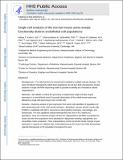Single-Cell Analysis of the Normal Mouse Aorta Reveals Functionally Distinct Endothelial Cell Populations
Author(s)
Kalluri, Aditya S.; Vellarikkal, Shamsudheen K.; Edelman, Elazer R.; Nguyen, Lan; Subramanian, Ayshwarya; Ellinor, Patrick T.; Regev, Aviv; Kathiresan, Sekar; Gupta, Rajat M.; ... Show more Show less
DownloadAccepted version (4.888Mb)
Open Access Policy
Open Access Policy
Creative Commons Attribution-Noncommercial-Share Alike
Terms of use
Metadata
Show full item recordAbstract
Background: The cells that form the arterial wall contribute to multiple vascular diseases. The extent of cellular heterogeneity within these populations has not been fully characterized. Recent advances in single-cell RNA-sequencing make it possible to identify and characterize cellular subpopulations. Methods: We validate a method for generating a droplet-based single-cell atlas of gene expression in a normal blood vessel. Enzymatic dissociation of 4 whole mouse aortas was followed by single-cell sequencing of >10 000 cells. Results: Clustering analysis of gene expression from aortic cells identified 10 populations of cells representing each of the main arterial cell types: fibroblasts, vascular smooth muscle cells, endothelial cells (ECs), and immune cells, including monocytes, macrophages, and lymphocytes. The most significant cellular heterogeneity was seen in the 3 distinct EC populations. Gene set enrichment analysis of these EC subpopulations identified a lymphatic EC cluster and 2 other populations more specialized in lipoprotein handling, angiogenesis, and extracellular matrix production. These subpopulations persist and exhibit similar changes in gene expression in response to a Western diet. Immunofluorescence for Vcam1 and Cd36 demonstrates regional heterogeneity in EC populations throughout the aorta. Conclusions: We present a comprehensive single-cell atlas of all cells in the aorta. By integrating expression from >1900 genes per cell, we are better able to characterize cellular heterogeneity compared with conventional approaches. Gene expression signatures identify cell subpopulations with vascular disease-relevant functions.
Date issued
2019-07Department
Massachusetts Institute of Technology. Institute for Medical Engineering & ScienceJournal
Circulation
Publisher
Ovid Technologies (Wolters Kluwer Health)
ISSN
0009-7322
1524-4539